When it comes to preparing a succulent and flavorful pork shoulder, one crucial factor to consider is managing the cooking temperature properly. Many home cooks and professional chefs swear by increasing the temperature after wrapping their pork shoulder to achieve that perfect balance of tenderness and depth of flavor. But what is the logic behind this technique, and how can you incorporate it into your cooking process to benefit your final result?
In this article, we will explore the science and reasoning behind the decision to increase temp after wrapping pork shoulder. We will discuss the benefits of this approach and guide how to execute this method in your kitchen effectively. From retaining moisture and achieving a tender texture to maximizing flavor and ensuring a beautifully browned exterior, you’ll be armed with all the knowledge needed to elevate your pork shoulder dish. So, let’s dive in and discover the secrets to unlocking the full potential of this popular and mouth-watering cut of meat.
What Cut To Use For Pulled Pork Shoulder?
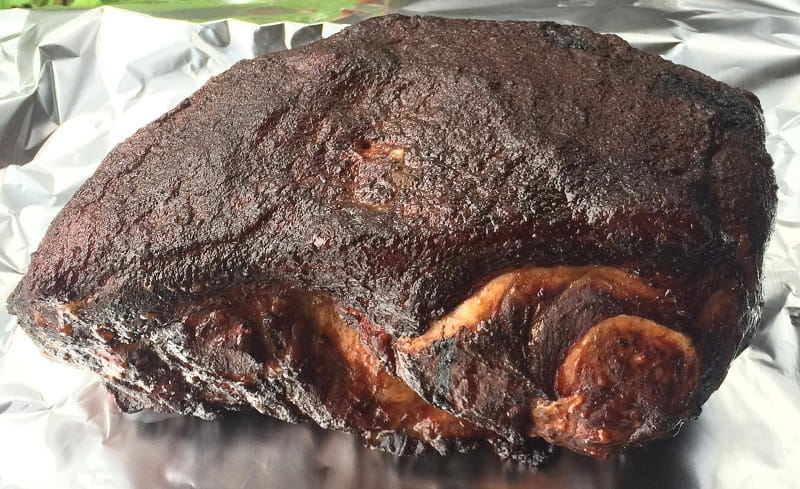
As a fan of slow-cooked pork, I have always wondered which cut of meat is best for pulled pork shoulder. After some research and experimentation, I have concluded that the Boston Butt is the perfect choice for juicy, tender pulled pork.
The Boston Butt is a pork cut from the upper part of the shoulder. It is typically sold bone-in and with the skin still attached. Don’t let the name fool you – this cut has nothing to do with the pig’s rear end! It was named after the way it was stored and transported in barrels called “butts” back in colonial times.
One of the reasons that the Boston Butt is ideal for pulled pork is its high-fat content. As the meat cooks low and slow, the fat melts, keeping the pork moist and flavorful. It also has a good amount of connective tissue, which breaks down during cooking, making the meat fall apart easily.
When To Wrap Pork Shoulder?
Wrapping is a crucial step in cooking pork shoulders. But when should you wrap your pork shoulder? There are two main schools of thought when it comes to wrapping pork shoulder: the “no wrap” method and the “wrap at the stall” method.
The “no wrap” method involves cooking the pork shoulder uncovered for the entire cooking time. This method allows the meat to develop a nice crust on the outside but also risks drying out the meat if it cooks for too long. If you choose to go this route, keep a close eye on the internal temperature of the meat to prevent overcooking.
The “wrap at the stall” method involves cooking the pork shoulder uncovered for the first few hours until it reaches a temperature of around 160°F. This is when the meat typically hits the “stall,” a period where the internal temperature plateaus and stops rising. You can wrap the pork shoulder in foil or butcher paper to help it power through the stall and continue cooking. This method can result in a faster cooking time and a juicier result.
So, when should you wrap your pork shoulder? It ultimately depends on your personal preference and cooking style. If you want a nice crust outside and don’t mind monitoring the meat closely, the “no wrap” method may be for you. If you want a faster cooking time and a juicier result, the “wrap at the stall” method is worth a try.
Read more:
- When To Wrap Pork Butt
- How Long To Smoke Pork Shoulder At 225
- How Long To Cook Pork Shoulder At 350
- Pork Loin Vs Pork Shoulder
Should I Increase Temp After Wrapping Pork Shoulder?
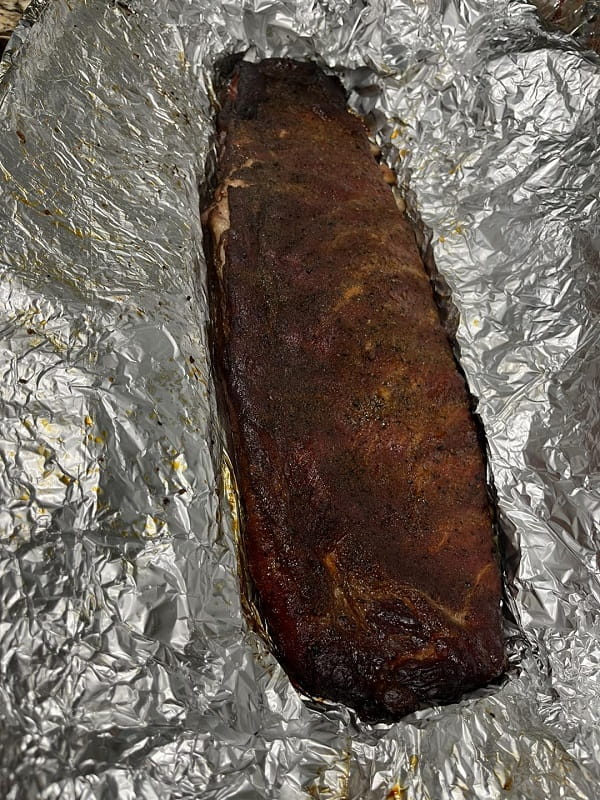
If someone wonders whether they should increase the temperature after wrapping their pork shoulder, the answer is yes! Wrapping the pork in foil can expedite the cooking process, and raising the temperature in the oven can help push the roast through the stall.
It’s okay to go as high as 350 degrees Fahrenheit, but the ideal time to wrap the pork is once it reaches an internal temperature of 160 to 165 degrees Fahrenheit. This should take about 5 to 6 hours of smoking. After wrapping, one can raise the temperature to 275-300 degrees Fahrenheit, as they no longer smoke the meat. They can shave off a few hours of cooking time and end up with perfectly smoked, juicy, tender pork shoulder. So, don’t hesitate to increase the temperature after wrapping the pork shoulder, and enjoy the delicious outcome!
What Are Some Of The Main Reasons Why It’s Important To Increase The Temperature After Wrapping Pork Shoulder?
I can tell you that increasing the temperature after wrapping is crucial to achieving the perfect result. There are a few key reasons why this step matters so much; I will break them down for you.
First, wrapping the pork shoulder is a common technique to keep the meat moist and tender during cooking. When you wrap the shoulder in foil or butcher paper, you create a sealed environment that traps moisture and helps the meat to cook evenly. However, this can also create a problem: the temperature inside the wrap can start to plateau or even drop slightly, slowing the cooking process and producing tough, dry meat.
That’s where increasing the temperature after wrapping comes in. By raising the temperature in your oven or smoker by 25-50 degrees Fahrenheit (depending on your recipe and cooking method), you can help to jumpstart the cooking process again and ensure that the pork shoulder cooks through to the center. This will also help to develop the delicious bark (crust) on the outside of the meat that everyone loves.
Another reason why it’s important to increase the temperature after wrapping has to do with food safety. Pork shoulder needs to be cooked to an internal temperature of at least 145 degrees Fahrenheit to be safe to eat. If the temperature inside the wrap drops too low for too long, there is a risk of harmful bacteria growing on the meat. Increasing the temperature ensures that the meat stays in the safe zone and avoids any risk of foodborne illness.
Finally, increasing the temperature after wrapping can help to reduce the cooking time overall. When the temperature inside the wrap drops, the cooking process slows down and can take longer than anticipated. By raising the temperature, you can get the pork shoulder up to temperature more quickly and enjoy your delicious meal sooner.
How Long Should You Wait Before Increasing The Temperature When Wrapping Pork Shoulder?
When cooking a delicious pork shoulder, knowing the perfect timing to wrap it to achieve juicy and tender meat is important. It’s best to wait until the internal temperature of the pork reaches about 160-165°F, which usually takes about 5-6 hours of cooking at low smoking temperatures between 225-250 degrees. Once the meat has been wrapped, it’s recommended to wait until the internal temperature of the pork reaches 180°F before unwrapping and allowing the bark to form in the last part of cooking. The temperature can be raised to 275-300°F to push the roast through the final stages.
With accurate temperature tools and careful monitoring, one can cut cooking time by 7 hours to achieve the perfect pork shoulder. Remember to cook it to an internal temperature of 195°F and let it rest for at least 30 minutes before serving.
What Is The Optimal Temperature Range To Increase To After Wrapping Your Pork Shoulder?
The ideal temperature range to raise your smoker or grill to after wrapping your pork shoulder is 275-300 degrees Fahrenheit. This temperature range is effective because it will help push the roast through and ensure the fat renders and collagen breaks down properly, resulting in a tender and juicy end product. It’s important to note that timing is also crucial when wrapping pork butt. It’s best to wrap it once the internal temperature reaches around 160-165 degrees Fahrenheit, typically taking approximately 5-6 hours of smoking.
The Differences In Temperature When Cooking A Wrapped Versus Unwrapped Pork Shoulder
One of the biggest temperature differences when cooking pork shoulder is whether you cook the meat wrapped or unwrapped. I’ll share my experiences with both methods and the temperature differences I noticed.
In my experience, cooking a wrapped pork shoulder requires a lower temperature than cooking it unwrapped. I typically aim for a temperature around 225-250 degrees Fahrenheit. This allows the meat to cook slowly and become tender while preventing it from drying out.
On the other hand, cooking an unwrapped pork shoulder involves leaving the meat exposed to the heat source. This method is often used for smoking or grilling but can also be done in the oven. Without the wrap, the meat will develop a crispy exterior and a smoky flavor.
However, cooking an unwrapped pork shoulder requires a higher temperature than cooking it wrapped. I usually aim for a temperature of around 300-325 degrees Fahrenheit. This higher temperature allows the meat to cook faster and develop that desired crispy exterior.
Of course, the exact temperature and cooking time will vary depending on the size of the pork shoulder and the method you choose. It’s important to use a meat thermometer to ensure the internal temperature reaches at least 145 degrees Fahrenheit for safe consumption.
How to Wrap Pork Shoulder?
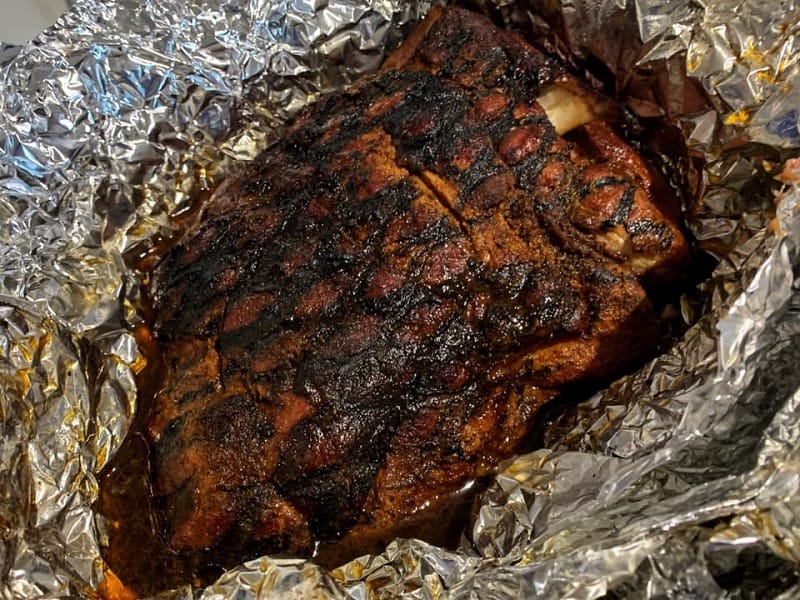
I’ll admit I used to struggle with wrapping Pork Shoulder properly. I’ve made plenty of mistakes, but I’ve learned a lot. So, let me share my tips with you.
First and foremost, choose the right wrap. I prefer to use butcher paper because it allows the meat to breathe and prevents it from sweating. However, aluminum foil can be used as well. Ensure that the shiny side faces inward to reflect heat onto the meat.
Before wrapping, season the pork shoulder generously with your favorite rub or spice blend. This will add flavor and create a delicious crust outside of the meat. I like to use a combination of salt, pepper, garlic powder, and paprika.
Next, position the pork shoulder in the center of the wrap. If there is a fat cap, make sure it is facing up. This will allow the fat to render down and baste the meat as it cooks. Fold the sides of the wrap-up and over the pork shoulder, and then bring the top and bottom of the wrap together to create a snug package.
Once the pork shoulder is wrapped, place it in a baking dish or sheet pan. This will prevent juices from leaking and making a mess in your oven. If you’re using butcher paper, make sure to tie the ends of the paper together with the butcher’s twine to keep the package secure.
Finally, cook the pork shoulder to your desired temperature. I recommend using a meat thermometer to ensure the meat reaches an internal temperature of 195-205°F. This will ensure that the meat is fall-apart tender and juicy.
Tips For Increasing Temperature On A Wrapped Pork Shoulder That You Recommend?
First things first, make sure that your thermometer is accurate. It’s easy to overlook, but a faulty thermometer can reduce your cooking time and leave you with undercooked meat. I recommend investing in a high-quality digital thermometer and testing it with boiling water to ensure it’s reading accurately.
Next, try increasing the temperature of your smoker or grill. Adding more fuel should do the trick if you’re using a smoker. Adjust the vents to increase the airflow and stoke the coals for a grill. Keep in mind that a sudden spike in temperature can shock the meat and cause it to toughen up, so make sure to increase the heat gradually.
Another trick is to unwrap the pork shoulder and place it directly on the grate. This will help increase the surface area and allow for more even cooking. Just be sure to keep an eye on it – without the protection of the wrap, the meat can dry out quickly.
You can finish the pork shoulder in the oven if none of these methods work. Preheat the oven to around 325°F and transfer the unwrapped pork shoulder to a baking dish or roasting pan. Cover it with foil and cook until it reaches the desired internal temperature.
Lastly, be patient. Pork shoulder is a tough cut of meat that requires low and slow cooking to break down the connective tissue and become tender. Rushing the process can result in a tough, dry end product. So even if the temperature isn’t increasing as quickly as you’d like, resist the temptation to crank up the heat and let the meat do its thing.
The Importance Of Monitoring The Temperature While Cooking A Wrapped Pork Shoulder?
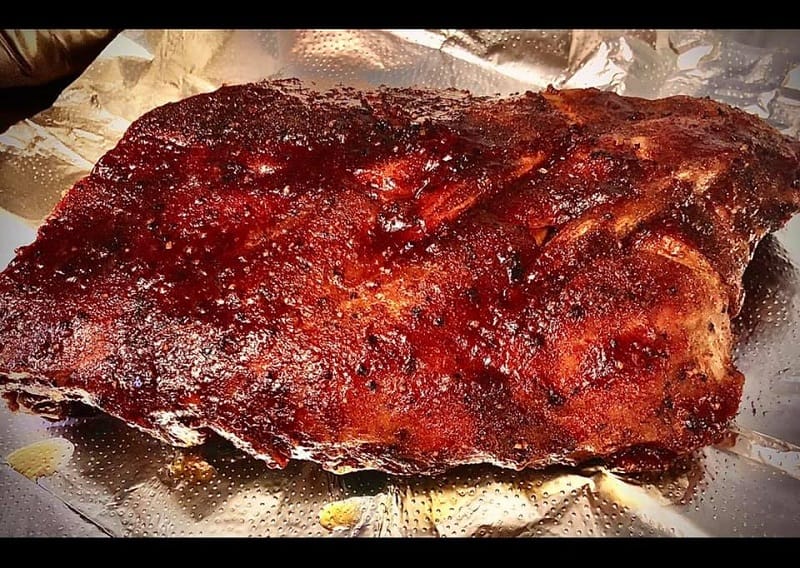
Monitoring the temperature is crucial because the pork shoulder is a tough and fatty cut of meat. It requires a slow and low cooking method to break down the connective tissues and render the fat, resulting in juicy and tender meat. However, if the temperature is too high or too low, the meat can dry and tough, ruining the entire dish.
To monitor the temperature, you will need a reliable meat thermometer. Insert the thermometer into the thickest part of the pork shoulder, ensuring not to touch the bone. The ideal temperature for a wrapped pork shoulder is between 190°F and 205°F. This range ensures the meat is fully cooked and has reached the desired tenderness.
Another reason why monitoring the temperature is vital is food safety. Consuming undercooked pork can lead to foodborne illnesses such as salmonella and E. coli. By monitoring the temperature, you can ensure the pork shoulder is fully cooked and safe to eat.
Common Mistakes When Attempting To Increase The Temperature After Wrapping A Pork Shoulder
One of the most common mistakes I see people make when smoking a pork shoulder is attempting to increase the temperature after it has been wrapped. Here are a few mistakes to avoid if you want to ensure a perfectly cooked pork shoulder.
Mistake #1: Not Giving Enough Time to Smoke
One of the biggest mistakes I see people make is not giving enough time for the meat to smoke before wrapping it. Smoking meat is a slow and steady process that requires patience. You want the smoke to penetrate the meat and infuse it with flavor, so give it enough time. Generally, you’ll want to smoke a pork shoulder for at least 6-8 hours before wrapping it.
Mistake #2: Not Wrapping the Meat Properly
When it comes time to wrap the pork shoulder, you’ll want to make sure that you wrap it tightly and securely. The best way to do this is to use heavy-duty aluminum foil or butcher paper. Be sure to wrap it tightly so that no steam can escape. This will help to keep the meat moist and tender during the rest of the cooking process.
Mistake #3: Trying to Increase the Temperature Too Quickly
Once the meat is wrapped, resisting the urge to increase the temperature too quickly is important. Doing so can cause the meat to dry out and become tough. Instead, you’ll want to maintain a steady temperature and allow the meat to cook slowly. This will help to break down the connective tissue and create a juicy, tender pork shoulder.
Mistake #4: Not Letting the Meat Rest
After the pork shoulder has finished cooking, it’s important to let it rest for at least 30 minutes before carving. This will allow the meat to reabsorb some of the lost juices during cooking. Cutting into the meat too soon can cause the juices to spill out and leave you with a dry, flavorless pork shoulder.
Can You Use Different Wood Chips To Smoke Your Pork Shoulder?
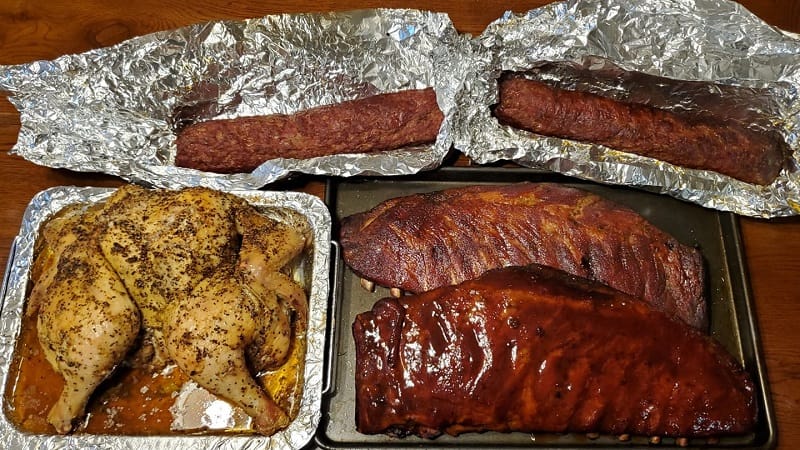
Well, the answer is yes! While some woods may be better suited for smoking pork than others, it all comes down to personal preference. Hickory, applewood, oak, pecan, cherry, and maple are all popular choices.
However, when it comes to smoking pork shoulder specifically, smoking chunks are recommended over smoking chips due to their larger size and slower burn time. So, next time you’re smoking a pork shoulder, don’t be afraid to experiment with different wood chips and find the perfect flavor.
How Do You Know When Your Pork Shoulder Is Done Cooking?
First of all, it’s important to note that pork shoulder is a tough cut of meat that requires low and slow cooking to break down the collagen and become tender. This means you’ll need to cook it for several hours for it to be fully cooked.
A meat thermometer can tell if your pork shoulder is done cooking. Insert the thermometer into the thickest part of the meat – it should read at least 145°F (63°C) for the pork to be safe to eat. However, if you want your pork to be even more tender, you can cook it at a higher temperature, such as 160°F (71°C) or 170°F (77°C). Remember that the higher the temperature, the drier the meat may become.
Another way to tell if your pork shoulder is done cooking is by gently pulling at the meat with a fork or tongs. It should be tender enough to pull apart easily if it’s fully cooked. If it’s still tough, it needs more time in the oven.
Lastly, if you’re cooking your pork shoulder in a slow cooker or Dutch oven, you can tell if it’s done by checking the bone. If the bone easily pulls away from the meat, it’s fully cooked.
Some Recommended Sides To Serve With Slow-Cooked Pork Shoulder
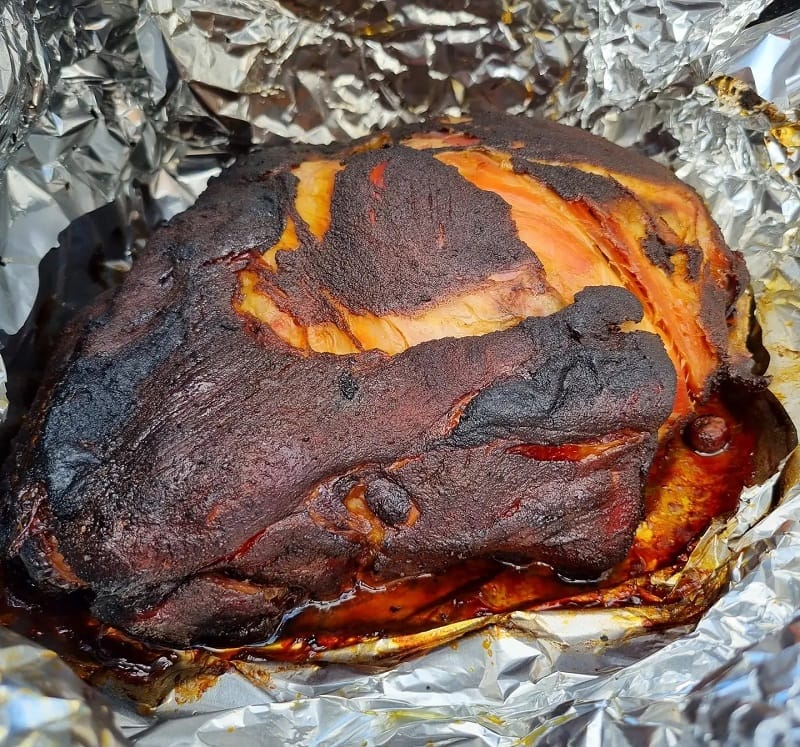
As delicious as a perfectly-cooked pork shoulder can be, it can be a bit of a challenge to figure out what to serve alongside it. So today, I wanted to share some of my favorite sides to serve with a slow-cooked pork shoulder – from classic comfort foods to fresh, flavorful salads.
- Mashed Potatoes: It might seem like a no-brainer, but there’s a reason that mashed potatoes are a classic side dish for a reason. The creaminess of the potatoes pairs perfectly with the rich, savory flavor of slow-cooked pork shoulder – and it’s an easy way to ensure you’ve got a filling, satisfying meal.
- Roasted Vegetables: Another easy, classic side dish option is roasting seasonal vegetables alongside your pork shoulder. I love to roast a mix of root vegetables like carrots, parsnips, and sweet potatoes, along with some Brussels sprouts or green beans for a pop of color.
- Coleslaw: If you’re looking for something a bit lighter to balance out the richness of the pork, coleslaw is a great option. The crunch of the cabbage and carrots adds a nice texture, and the tangy dressing perfectly complements the savory pork.
- Cornbread: Cornbread is a must-have side dish for a true Southern-inspired meal. The sweetness of the cornbread is a great contrast to the savory pork, and you can even add some jalapenos or cheddar cheese to give it an extra kick.
- Grilled Pineapple: If you’re feeling adventurous, grilled pineapple is a surprisingly delicious side dish for pork shoulder. The sweetness of the pineapple complements the savory pork perfectly, and the slight caramelization from grilling adds a nice smokiness.
- Kale Salad: A kale salad is an excellent choice for a healthy side dish. The bitterness of the kale pairs well with the sweetness of dried cranberries or raisins, and you can add some toasted nuts or cheese for a bit of extra flavor.
Should You Let Your Pork Shoulder Rest Before Slicing And Serving?
When cooking a pork butt, it’s essential to let it rest for a certain period before slicing and serving. The minimum time to rest a pork butt is about 15 minutes, but it’s recommended to rest it for at least two hours. This resting period allows the meat to absorb moisture and retains its flavors and juices.
One can wrap the pork butt in aluminum foil, butcher paper, or a towel and place it in a cooler for a few hours to rest. If one is rushed for time, they can opt for a 30-45 minute resting period, but it may not provide the same tender and juicy results as a more extended resting time. Allowing the meat time to rest ensures a delicious and satisfying meal for their family and friends.
FAQs About Increase Temp After Wrapping Pork Shoulder
Is It Better To Cook Pork Shoulder Low And Slow, Or At A Higher Temperature For A Shorter Amount Of Time?
Cooking pork shoulder low and slow is recommended for the best results. Cooking the meat at a higher temperature will result in a tougher result. The low and slow cooking method allows the meat to break down and become tender while absorbing smoky flavors. While it may take more time, the result will be worth it. However, if someone is looking for a faster way to cook their pork shoulder, they can use a higher temperature but should be aware of the potential for a tougher result. Ultimately, it depends on the individual’s preference and timeline, but low and slow is generally the way to go for the best-tasting pulled pork.
How Can You Ensure Your Pork Shoulder Stays Moist And Tender During The Cooking Process?
If you’re craving juicy, tender pork shoulder, you can do a few things to ensure your meat stays moist and tender during the cooking process. One helpful tip is to keep a spray bottle filled with a mixture of water and apple juice or apple cider vinegar nearby while smoking or reheating the meat. This will help replace lost moisture and keep the meat from getting dry.
Additionally, using a probe thermometer to check the internal temperature of the pork will help ensure it’s cooked to at least 145°F. To further retain the moisture content of the dish, wrap the meat in towels and place it in a cooler after cooking. Wrapping the meat during cooking can also be helpful, but it should be done once the internal temperature reaches around 160-170°F.
What Materials Should You Use To Wrap Your Pork Shoulder?
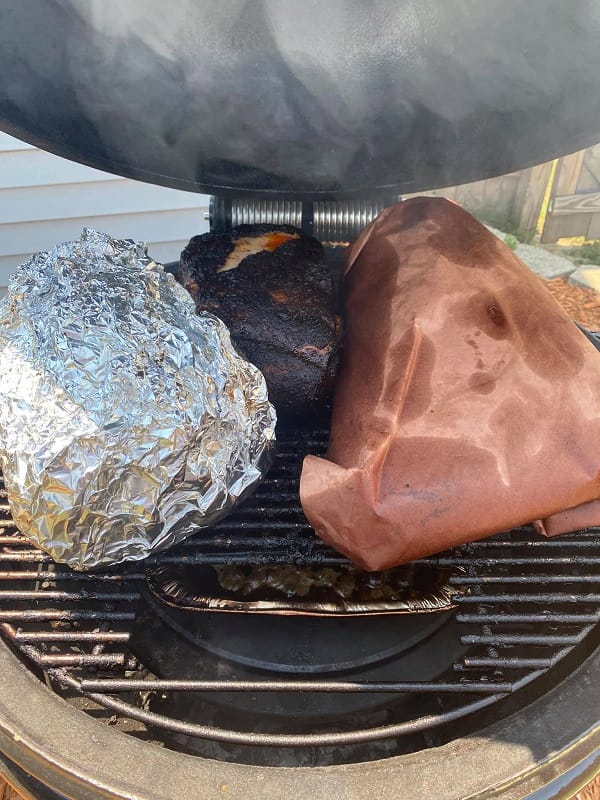
When wrapping a pork shoulder roast, there are a few different materials. Aluminum foil is a popular option, as it creates a seal that locks in moisture, though it can soften the bark. Butcher paper is an excellent alternative as it is tough enough to retain moisture while keeping the bark intact. It may be more difficult to wrap, but it is worth the effort.
The choice between the two ultimately comes down to personal preference. If using aluminum foil, it is best to use wide sheets four times as long as the widest side of the pork. For a better crunch, meat paper can be used, but make sure it is new and safe for food consumption. Whatever material is used, the result should be a delicious and tender pork shoulder roast.
Conclusion
In conclusion, consider increasing the temperature after wrapping the meat if you’re looking to speed up the smoking process and still achieve a delicious, juicy pork shoulder. It may take a little experimentation to find the perfect temperature for your smoker and the size of your pork shoulder, but the results are well worth it. So try it and enjoy your perfectly cooked, mouthwatering pork shoulder!
Do you have any questions about increase temp after wrapping pork shoulder? Let us know in the comments below.
References:
- https://www.masterclass.com/articles/how-to-wrap-a-smoked-pork-butt-with-pitmaster-aaron-franklin
- https://www.thekitchn.com/heres-everything-you-need-to-know-about-pork-shoulder-4-ways-to-cook-it-242362

Hey readers! Chip Holland here, and I’m a Manager of this website. My passion for writing about it only matches my passion for BBQ. Follow my blog for mouth-watering recipes, tips, and tricks for the perfect smoke, grill, and BBQ. I’m sure you won’t be disappointed!
